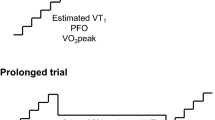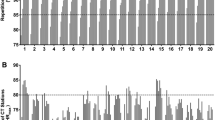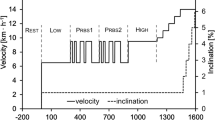Abstract
Purpose
To determine the impact of breathing valve resistance on peak aerobic capacity (\(\dot {V}{{\text{O}}_{\text{2}}}{\text{peak}}\)) and running economy (RE) in endurance-trained and recreationally active individuals.
Methods
Ten endurance-trained males (ETM), 10 endurance-trained females (ETF), 10 recreationally active males (RAM), and 10 recreationally active females (RAF) participated in this study. On two separate occasions, subjects performed identical graded exercise treadmill protocols using either a Hans Rudolph 2700 (high resistance) or a Daniels’ (low resistance) two-way non-rebreathing valve. Parameters obtained from these protocols included energy expenditure (EE), ventilation (\({\dot {V}_{\text{E}}}\)), heart rate, respiratory exchange ratio, RE, \(\dot {V}{{\text{O}}_{\text{2}}}{\text{peak}}\), and time to exhaustion (TTE).
Results
When using the Daniels’ valve, all groups had lower submaximal EE (− 2.4, − 3.4, − 2.7, and − 2.0% for ETM, ETF, RAM, and RAF) and better RE (− 2.7, − 3.5, − 1.9, and − 1.8% for ETM, ETF, RAM and RAF) across all submaximal speeds. Only the ET groups had lower submaximal \({\dot {V}_{\text{E}}}\) (4.6 and 3.8% for ETM and ETF) when using the Daniels’ valve. TTE increased when using the Daniels’ valve for all groups (6.0, 10.9, 6.2 and 9.8% for ETM, ETF, RAM and RAF), but \(\dot {V}{{\text{O}}_{\text{2}}}{\text{peak}}\) was unaltered.
Conclusion
Compared to the Daniels’ valve, the Hans Rudolph 2700 valve altered the assessment of RE, submaximal EE, and TTE regardless of fitness level or sex, but did not change \(\dot {V}{{\text{O}}_{\text{2}}}{\text{peak}}\). Therefore, airflow resistance of a breathing valve must be considered when assessing and comparing EE, RE and TTE in the applied and research settings.


Similar content being viewed by others
Abbreviations
- EE:
-
Energy expenditure
- ETF:
-
Endurance-trained females
- ETM:
-
Endurance-trained males
- GXT:
-
Graded exercise test
- RAF:
-
Recreationally active females
- RAM:
-
Recreationally active males
- TTE:
-
Time to exhaustion
- \({\dot {V}_{\text{E}}}\) :
-
Expired ventilation
- \(\dot {V}{\text{C}}{{\text{O}}_{\text{2}}}\) :
-
Carbon dioxide production
- \(\dot {V}{{\text{O}}_{\text{2}}}\) :
-
Oxygen consumption
- \(\dot {V}{{\text{O}}_{\text{2}}}{\text{peak}}\) :
-
Peak oxygen consumption
- WOB:
-
Work of breathing
References
Babcock MA, Pegelow DF, Harms CA et al (2002) Effects of respiratory muscle unloading on exercise-induced diaphragm fatigue. J Appl Physiol 93:201–206
Barclay JK (1986) A delivery-independent blood flow effect on skeletal muscle fatigue. J Appl Physiol 61(3):1084–1090
Bassett DR, Howley ET (2000) Limiting factors for maximum oxygen uptake and determinants of endurance performance. Med Sci Sports exerc 32(1):70–84
Bassett DR, Howley ET, Thompson DL et al (2001) Validity of inspiratory and expiratory methods of measuring gas exchange with a computerized system. J Appl Physiol 91:218–224
Burnley M, Jones AM (2007) Oxygen uptake kinetics as a determinant of sports performance. Eur J Sport Sci 7(2):63–79
Cole MA, Brown MD (2000) Response of the human triceps surae muscle to electrical stimulation during varying levels of blood flow restriction. Eur J Appl Physiol 82(1–2):39–44
Daniels J (1971) Portable respiratory gas collection equipment. J Appl Physiol 31(1):164–167
Daniels J, Daniels N (1992) Running economy of elite male and elite female runners. Med Sci Sports Exerc 24(4):483–489
Dempsey JA, Romer L, Rodman J et al (2006) Consequences of exercise-induced respiratory muscle work. Respir Physiol Neurobiol 151(2):242–250
Dominelli PB, Render JN, Molgat-Seon Y et al (2015) Oxygen cost of exercise hyperpnoea is greater in women compared with men. J Physiol 593(8):1965–1979
Dominelli PB, Archiza B, Ramsook AH et al (2017) Effects of respiratory muscle work on respiratory and locomotor blood flow during exercise. Exp Physiol 102(11):1535–1547
Dressendorfer RH, Wade CE, Bernauer EM (1977) Combined effects of breathing resistance and hyperoxia on aerobic work tolerance. J Appl Physiol 42(3):444–448
Folinsbee LJ, Wallace ES, Bedi JF et al (1982) Exercise respiratory pattern in elite cyclists and sedentary subjects. Med Sci Sports Exerc 15(6):503–509
Guenette JA, Witt JD, McKenzie DC et al (2007) Respiratory mechanics during exercise in endurance trained men and women. J Physiol 581(3):1309–1322
Hankinson JL, Odencrantz JR, Fedan KB (1999) Spirometric reference values from a sample of the general US population. Am J Respir Crit Care Med 159(1):179–187
Hans Rudolph I (2017) Two way non rebreathing valves. Hans Rudolph, Inc. http://www.rudolphkc.com/img/uploads/pdf/691017%201017%20N.pdf. Accessed 27 July 2017
Harms CA, Babcock MA, McClaran SR et al (1997) Respiratory muscle work compromises leg blood flow during maximal exercise. J Appl Physiol 82(5):1573–1583
Harms CA, Wetter TJ, McClaran SR et al (1998) Effects of respiratory muscle work on cardiac output and its distribution during maximal exercise. J Appl Physiol 85(2):609–618
Harms CA, Wetter TJ, Croix CMS et al (2000) Effects of respiratory muscle work on exercise performance. J Appl Physiol 89(1):131–138
Hogan MC, Gladden LB, Grassi B et al (1998) Bioenergetics of contracting skeletal muscle after partial reduction of blood flow. J Appl Physiol 84(6):1882–1888
Jones AM (1998) A five year physiological case study of an Olympic runner. Br J Sports Med 32(1):39–43
Joyner MJ (1991) Modeling: optimal marathon performance on the basis of physiological factors. J Appl Physiol 70(2):683–687
Joyner MJ, Coyle EF (2008) Endurance exercise performance: the physiology of champions. J Physiol 586(1):35–44
Kaminsky LA, Areana R, Myers J (2015) Reference standards for cardiorespiratory fitness measured with cardiopulmonary exercise testing: data from the Fitness Registry and the Importance of Exercise National Database. Mayo Clinic Proc 90(11):1515–1523
Kane LA, Ryan BJ, Schmidt W et al (2016) Acute, low-dose CO inhalation does not alter energy expenditure during submaximal exercise. Int J Sports Med 37(01):19–24
Mclaughlin JE, Howley ET, Bassett DR et al (2010) Test of the classic model for predicting endurance running performance. Med Sci Sports Exerc 42(5):991–997
Miller MR, Hankinson J, Brusasco V et al (2005) Standardisation of spirometry. Eur Respir J 26(2):319–338
Péronnet F. Massicotte D (1991) Table of nonprotein respiratory quotient: an update. Can J Sport Sci 16(1):23–29
Rabischong E, Guiraud D (1993) Determination of fatigue in the electrically stimulated quadriceps muscle and relative effect of ischaemia. J Biomed Eng 15(6):443–450
Romer LM, Lovering AT, Haverkamp HC et al (2006) Effect of inspiratory muscle work on peripheral fatigue of locomotor muscles in healthy humans. J Physiol 571(2):425–439
Wanger J (2011) Pulmonary function testing. Jones & Bartlett Publishers, Burlington, 172 p
Wetter TJ, Harms CA, Nelson WB et al (1999) Influence of respiratory muscle work on VO2 and leg blood flow during submaximal exercise. J Appl Physiol 87(2):643–651
Acknowledgements
We would like to thank the study volunteers for their participation. We also would like to thank Jenna Turner for study assistance.
Funding
This research was partially funded by the Undergraduate Research Opportunity Program from the University of Colorado Boulder.
Author information
Authors and Affiliations
Contributions
SK, EH and WB conceived and designed research. SK conducted experiments, analyzed data and wrote the manuscript. All authors read, edited and approved the manuscript.
Corresponding author
Ethics declarations
Conflict of interest
The authors declare that they have no conflict of interest.
Additional information
Communicated by Susan Hopkins.
Rights and permissions
About this article
Cite this article
Kim, S., Homestead, E.P. & Byrnes, W.C. Breathing valve resistance alters physiological responses during a graded exercise test. Eur J Appl Physiol 118, 1921–1929 (2018). https://doi.org/10.1007/s00421-018-3922-z
Received:
Accepted:
Published:
Issue Date:
DOI: https://doi.org/10.1007/s00421-018-3922-z




